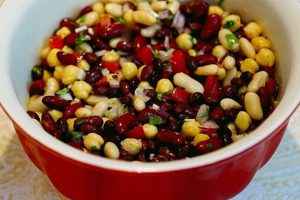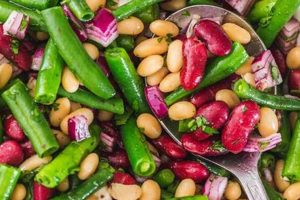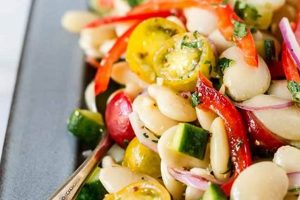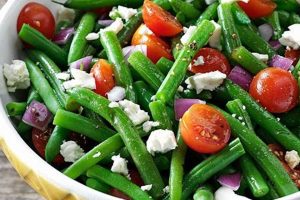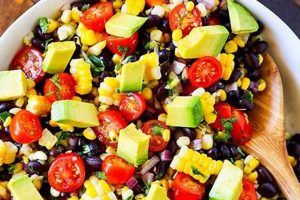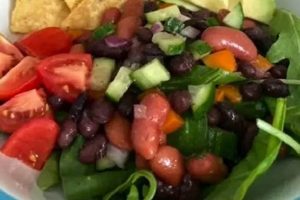A simple, refreshing dish typically combines three varieties of beans, often canned or pre-cooked, with a vinaigrette-based dressing. Common ingredients include kidney beans, cannellini beans, and black beans, though variations exist. These are tossed with diced onion, bell pepper, and sometimes celery, then marinated in a dressing that frequently incorporates vinegar, oil, herbs, and spices. The result is a flavorful, protein-rich salad suitable as a side dish, light lunch, or potluck contribution.
This type of salad offers several nutritional advantages. Beans are excellent sources of protein and fiber, contributing to satiety and digestive health. They also provide essential minerals and vitamins. The colorful vegetables incorporated add further nutritional value and antioxidants. The customizable nature of the dish allows for adaptations to individual dietary needs and preferences, including using low-sodium beans and adjusting the dressing ingredients. Its relatively long shelf-life makes it a practical option for meal prepping.
This overview provides a foundation for exploring variations on the basic formula. Discussions regarding ingredient selection, dressing options, and serving suggestions will follow.
Tips for a Superior Three-Bean Salad
Elevating a basic three-bean salad from satisfactory to exceptional involves attention to detail and a few key techniques. The following tips offer guidance for achieving optimal flavor and texture.
Tip 1: Rinse canned beans thoroughly. This removes excess starch and sodium, resulting in a cleaner flavor and improved texture.
Tip 2: Consider quick-pickling the onions. Briefly soaking diced red onion in red wine vinegar mellows their pungency and adds a vibrant color and tangy flavor dimension.
Tip 3: Explore diverse bean varieties. While kidney, cannellini, and black beans are common, experimenting with chickpeas, pinto beans, or even edamame can introduce unique textures and flavor profiles.
Tip 4: Fresh herbs enhance the flavor profile. Chopped parsley, cilantro, or dill add brightness and complexity to the salad.
Tip 5: Balance the dressing. A harmonious blend of acidity, sweetness, and savory elements is crucial. Adjust the proportions of vinegar, oil, and seasonings to achieve the desired balance.
Tip 6: Allow adequate marinating time. The flavors meld and deepen as the salad rests. Ideally, refrigerate for at least 30 minutes before serving, allowing the beans to absorb the dressing.
By incorporating these tips, one can create a three-bean salad that is both flavorful and visually appealing. Attention to these details elevates the dish beyond a simple side to a culinary highlight.
These techniques provide a pathway to mastering this versatile dish, offering a foundation for creativity and customization. The following section will explore variations and serving suggestions.
1. Bean Selection
Bean selection is paramount in a three-bean salad recipe. It directly influences the dish’s nutritional value, textural complexity, and overall flavor profile. A thoughtful combination of beans elevates the salad from simple to sophisticated. The following facets highlight the key considerations for bean selection.
- Variety:
Diversity in bean types is crucial for a well-rounded salad. Each variety contributes unique characteristics. For example, kidney beans offer a robust, earthy flavor and firm texture, while cannellini beans provide a creamy texture and delicate taste. Black beans contribute a mild, slightly sweet flavor and a smooth texture. This interplay of textures and tastes creates a more engaging culinary experience.
- Texture:
The interplay of textures is essential for a satisfying salad. Combining beans with varying textures, such as firm kidney beans with softer chickpeas or black beans, prevents a monotonous mouthfeel. This contrast adds depth and interest to each bite.
- Color:
Visual appeal enhances the dining experience. A mix of colors, such as the deep red of kidney beans, the creamy white of cannellini beans, and the jet black of black beans, creates a vibrant and appetizing presentation. Color variation also subtly suggests flavor diversity.
- Nutritional Value:
Different beans offer varying nutritional profiles. Combining different types maximizes the range of vitamins, minerals, and fiber. For example, kidney beans are rich in iron and protein, while black beans are a good source of folate and antioxidants. Incorporating a variety ensures a nutritionally balanced meal.
Careful bean selection is thus integral to a successful three-bean salad. A considered approach to variety, texture, color, and nutritional content elevates the final dish, transforming it into a balanced and enjoyable culinary creation. These factors contribute not only to taste and texture but also to the overall nutritional value and visual appeal of the salad.
2. Dressing Vibrancy
Dressing vibrancy is integral to a successful three-bean salad recipe. The dressing provides the flavor foundation, unifying the diverse textures and inherent flavors of the beans. A vibrant dressing doesn’t merely coat the beans; it enhances and elevates them, transforming the individual components into a cohesive and flavorful whole. A bland or unbalanced dressing can render the salad dull, regardless of the quality of the beans. For instance, a simple vinaigrette made with high-quality extra virgin olive oil, a bright vinegar like red wine or apple cider, and fresh herbs like dill or parsley can significantly elevate the overall taste experience. The acidity of the vinegar cuts through the richness of the beans, while the oil provides a smooth mouthfeel and carries the flavors of the herbs.
The concept of vibrancy extends beyond basic flavor. It encompasses the color, aroma, and textural contribution of the dressing. A dressing with a vibrant color, such as a deep red from sun-dried tomatoes or a bright green from fresh herbs, enhances the visual appeal of the salad. The aroma should be equally enticing, stimulating the appetite before the first bite. Even the texture of the dressing plays a role. A slightly emulsified vinaigrette clings to the beans, ensuring each bite is infused with flavor, while a thicker dressing might overwhelm the delicate textures of the beans. Consider a lemon-herb vinaigrette: the bright yellow color adds visual interest, the citrusy aroma is refreshing, and the slight emulsion coats the beans evenly.
Achieving dressing vibrancy requires careful consideration of ingredients and balance. High-quality ingredients are essential. Freshly squeezed lemon juice provides a brighter, more complex flavor than bottled juice. Freshly ground spices offer a more intense aroma and flavor than pre-ground versions. Balance is equally crucial. The acidity of the vinegar should be balanced by the sweetness of any added sugar or the richness of the oil. The flavors of the herbs and spices should complement, not overpower, the natural flavors of the beans. Understanding these principles allows for tailored dressings, specific to the chosen bean varieties, ensuring a harmonious and flavorful final product. Successfully balancing these elements results in a dressing that not only complements the beans but elevates the entire dish, creating a truly vibrant and satisfying culinary experience.
3. Ingredient Freshness
Ingredient freshness significantly impacts the overall quality of a three-bean salad. Fresh ingredients contribute not only to superior flavor but also to enhanced texture, visual appeal, and nutritional value. The delicate nature of a vinaigrette-based dressing necessitates fresh components to prevent off-flavors and ensure a balanced taste profile. Consider the difference between freshly chopped bell peppers, crisp and vibrant, versus those nearing spoilage, which exhibit a dull appearance and diminished flavor. This distinction underscores the importance of ingredient freshness.
The impact of fresh herbs is particularly noteworthy. Dried herbs can be used in some culinary contexts, but in a three-bean salad, where delicate flavors are paramount, fresh herbs provide a brightness and complexity that dried herbs often lack. Fresh parsley, dill, or cilantro, finely chopped and added to the salad, contribute a vibrancy that significantly elevates the overall sensory experience. Their aromatic oils, released when chopped, infuse the salad with a fresh, herbaceous aroma, enhancing its appeal. Furthermore, the visual appeal of fresh herbs adds a touch of vibrancy, enhancing presentation. Using wilted or aged herbs, conversely, can introduce undesirable bitterness and detract from the overall freshness of the salad. Therefore, prioritizing fresh, high-quality herbs is essential for achieving optimal results.
Maintaining ingredient freshness requires proper storage and handling techniques. Storing vegetables in airtight containers in the refrigerator helps preserve their crispness and prevents them from absorbing unwanted odors. Herbs should be stored similarly or wrapped in damp paper towels to maintain their moisture content. Using ingredients promptly after purchase ensures optimal flavor and texture. Adherence to these practices guarantees a three-bean salad that exemplifies freshness in every aspect, from flavor and texture to visual appeal and nutritional value. Compromising on ingredient freshness can result in a dish that falls short of its full potential, demonstrating the integral role freshness plays in achieving a truly exceptional three-bean salad.
4. Proper Draining
Proper draining is a crucial step in a three-bean salad recipe, directly impacting the final dish’s texture, flavor, and overall appeal. Undrained beans introduce excess liquid, diluting the dressing and creating a watery, unappetizing salad. This excess moisture also compromises the structural integrity of the salad, causing the beans to become mushy and the other ingredients to lose their crispness. The dressing’s flavor profile becomes muted, and the overall culinary experience suffers. Imagine a vibrant, flavorful vinaigrette designed to complement the beans, becoming thin and watery due to inadequately drained beans. The flavors become indistinct, and the salad lacks the desired balance.
Thorough draining mitigates these issues. It ensures that the beans maintain their individual texture and shape, preventing them from becoming waterlogged. This, in turn, allows the dressing to adhere properly, coating each bean evenly and delivering the intended flavors. Furthermore, proper draining prevents the dilution of the dressing, preserving its intended vibrancy and allowing it to effectively complement the other ingredients. For example, consider a salad with crisp bell peppers and red onion. If the beans are not drained properly, these vegetables also become soggy, losing their textural contrast and diminishing the overall enjoyment of the salad. In contrast, properly drained beans allow these vegetables to retain their crispness, contributing to a more satisfying textural experience.
Achieving optimal drainage requires more than simply opening a can and pouring out the liquid. Rinsing the beans under cold water removes excess starch and sodium, further enhancing their flavor and texture. This rinsing process also helps to separate any beans that may be clinging together, ensuring even distribution throughout the salad. Once rinsed, the beans should be placed in a colander or fine-mesh sieve and allowed to drain completely. Gently shaking the colander or patting the beans with a paper towel can expedite the process. This attention to detail ensures a finished salad that is not only flavorful and visually appealing but also exhibits the desired textural complexity. The proper drainage of beans, therefore, constitutes a fundamental step in any three-bean salad recipe, directly influencing its success and contributing significantly to the overall culinary experience.
5. Marination Time
Marination time plays a crucial role in the flavor development of a three-bean salad. The process allows the dressing to permeate the beans, softening their texture and infusing them with the intended flavors. This absorption process is gradual and time-dependent. A brief marination period may result in a salad where the dressing merely coats the surface of the beans, leaving their interior relatively unaffected. Conversely, adequate marination time ensures that the flavors penetrate deeply, resulting in a more harmonious and flavorful salad. For instance, a salad marinated for only 30 minutes may exhibit a noticeable contrast between the flavorful exterior and the bland interior of the beans, while a salad marinated for several hours allows the flavors to meld and deepen, creating a more cohesive and enjoyable taste experience. The chemical processes involved include diffusion and osmosis, where the acidic components of the dressing break down the beans’ outer layers and allow the flavors to penetrate.
The optimal marination time depends on several factors, including the type of beans used, the acidity of the dressing, and the desired flavor intensity. Larger, denser beans like kidney beans typically require a longer marination period compared to smaller beans like black beans. Similarly, a more acidic dressing will penetrate the beans more quickly than a less acidic one. The desired flavor intensity also influences the ideal marination time. A longer marination period generally results in a more pronounced flavor profile. Practical considerations also influence marination time. While overnight marination can yield exceptional results, shorter periods of 2-4 hours can still produce a flavorful salad, especially if the beans are pre-soaked. Understanding these variables allows for adjustments based on individual preferences and time constraints, ensuring a flavorful and well-balanced salad.
In conclusion, marination time is not merely a procedural step but a critical determinant of flavor development and textural harmony in a three-bean salad. A balanced approach, considering the interplay between bean variety, dressing acidity, and desired flavor intensity, yields optimal results. Attention to this detail elevates the final dish, transforming it from a simple combination of ingredients into a cohesive and flavorful culinary creation. Failure to account for adequate marination time can result in a salad that lacks depth and complexity, highlighting the practical significance of understanding this key element of the recipe.
6. Flavor Balance
Flavor balance is paramount in a successful three-bean salad recipe. It represents the harmonious interplay of sweet, sour, salty, and savory elements, creating a complex and satisfying taste profile. A well-balanced salad avoids extremes, ensuring no single flavor dominates. Instead, each element complements the others, resulting in a cohesive and enjoyable culinary experience. This balance is crucial because the inherent simplicity of the ingredients requires careful consideration of their interaction to achieve a dish that transcends its basic components. Without proper balance, the salad can be overly sweet, excessively tart, or bland and unappealing.
- Acidity:
Acidity, typically derived from vinegar or citrus juice, provides brightness and cuts through the richness of the beans. It acts as a counterpoint to sweetness and adds a refreshing tang. For instance, a red wine vinaigrette contributes a subtle tartness that balances the sweetness of the beans and any added sugar in the dressing. Without sufficient acidity, the salad can taste flat and heavy. However, excessive acidity can make it unpleasantly sour. The right balance enhances the other flavors without overpowering them.
- Sweetness:
Sweetness, often from added sugar or a naturally sweet ingredient like diced red onion, tempers the acidity and adds depth of flavor. A touch of sweetness rounds out the flavor profile, preventing the salad from being too tart. For example, a small amount of sugar or honey in the dressing can balance the sharpness of the vinegar. However, excessive sweetness can mask the other flavors and make the salad cloying. The key is to use sweetness judiciously to achieve a balanced and harmonious taste.
- Saltiness:
Salt enhances the other flavors and provides a savory backbone to the salad. It acts as a flavor enhancer, bringing out the nuances of the beans, vegetables, and herbs. A pinch of salt in the dressing or added directly to the beans during cooking can significantly improve the overall taste. However, too much salt can overpower the other flavors and make the salad unpleasant. Careful seasoning is crucial to achieve the desired balance.
- Savory Notes:
Savory notes, often derived from ingredients like herbs, spices, or aromatics, add complexity and depth. These elements contribute layers of flavor, preventing the salad from being one-dimensional. Fresh herbs like parsley, dill, or cilantro add brightness and a fresh, herbaceous note. Spices like cumin or chili powder introduce warmth and complexity. The choice of savory elements depends on personal preference and the desired flavor profile. However, it’s important to use these ingredients judiciously to avoid overpowering the delicate balance of flavors.
In the context of a three-bean salad, flavor balance is not merely a desirable characteristic; it’s essential for creating a truly enjoyable dish. The careful interplay of acidity, sweetness, saltiness, and savory notes elevates the simple combination of beans and vegetables, transforming it into a complex and satisfying culinary experience. Achieving this balance requires a nuanced understanding of how these elements interact and the ability to adjust them accordingly. A successful three-bean salad recipe hinges on this delicate balance, demonstrating the critical role of flavor in creating a dish that is both refreshing and flavorful.
Frequently Asked Questions
This section addresses common inquiries regarding three-bean salad preparation and storage.
Question 1: What type of vinegar is best suited for a three-bean salad dressing?
While various vinegars can be utilized, red wine vinegar, apple cider vinegar, and white wine vinegar are frequently preferred for their balanced acidity and complementary flavor profiles. The specific choice depends on the desired flavor outcome. Red wine vinegar imparts a robust tang, apple cider vinegar offers a slightly sweeter note, and white wine vinegar provides a milder acidity.
Question 2: Can dried beans be used in a three-bean salad?
Dried beans require pre-soaking and cooking before inclusion in a three-bean salad. Canned beans offer convenience, but dried beans allow for greater control over sodium content and texture. If using dried beans, ensure they are fully cooked yet retain their shape to maintain the salad’s structural integrity. Undercooked beans will be too firm, while overcooked beans may become mushy and disintegrate in the salad.
Question 3: How long can three-bean salad be stored in the refrigerator?
Properly stored in an airtight container, three-bean salad typically lasts for 3-5 days in the refrigerator. However, factors such as ingredient freshness and storage temperature can influence shelf life. Always inspect the salad for any signs of spoilage, such as off-odors or mold growth, before consumption. Discard the salad if any spoilage is suspected.
Question 4: Can three-bean salad be frozen?
Freezing is not generally recommended for three-bean salad. Freezing can negatively affect the texture of the beans and other vegetables, making them mushy upon thawing. The dressing can also separate and become watery. While freezing might extend shelf life, the compromised quality often outweighs this benefit. It’s preferable to prepare and consume the salad within the recommended refrigeration timeframe.
Question 5: How can sodium content be reduced in three-bean salad?
Sodium content can be minimized by using low-sodium or no-salt-added canned beans, rinsing canned beans thoroughly, and carefully controlling the amount of salt added to the dressing. Using dried beans offers the greatest control over sodium levels, as the cooking process allows for customized seasoning. These measures ensure a healthier and more flavorful salad without compromising taste.
Question 6: What are some variations on the classic three-bean salad recipe?
Numerous variations exist, allowing for customization based on dietary preferences and available ingredients. Different bean varieties, such as chickpeas, pinto beans, or lima beans, can be incorporated. Other vegetables, including corn, chopped celery, or diced tomatoes, can add flavor and textural complexity. Various herbs and spices can also be used to enhance the dressing’s flavor profile. These adaptable elements permit endless customization possibilities.
Understanding these commonly addressed questions facilitates successful three-bean salad preparation and storage, ensuring a flavorful and enjoyable culinary experience. Attention to these details often differentiates a mediocre salad from an exceptional one.
Further exploration of recipe variations and serving suggestions follows.
Conclusion
This exploration of three-bean salad recipes has highlighted key elements crucial for a successful outcome. Careful bean selection, considering variety, texture, and color, contributes to a balanced and visually appealing dish. Dressing vibrancy, achieved through fresh ingredients and a harmonious blend of acidity, sweetness, and savory notes, elevates the salad beyond its simple components. Proper draining, essential for maintaining textural integrity, and adequate marination time, crucial for flavor development, further contribute to the overall quality. Ingredient freshness and flavor balance are paramount, ensuring a vibrant and satisfying culinary experience.
The adaptability of this classic dish allows for endless variations, encouraging culinary creativity and customization based on individual preferences and dietary needs. By understanding these fundamental principles, one can consistently create a three-bean salad that is not only nutritious and flavorful but also a testament to the potential of simple ingredients when combined with thoughtful preparation.

